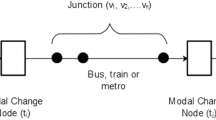Abstract
Various traffic network usage formats have arisen along with the popularization of automobiles and the continued service extension of busses, subways, and other forms of public transportation. Due to various characteristics of public transportation networks, unlike general street networks, many issues can affect public transportation, and an optimal course search should be considered. Present research considers plans to improve the overall efficiency of public transportation systems with regard to destination, means, route, and other factors to be selected efficiently in this environment as public transportation usage increases. From this perspective, it suggests the characteristics that a multimodal transit network route search algorithm should have and a corrective algorithm that implements this in an applicable program. Implementation was done in Google android application which provides a simple user interface to find optimal routes in Google Map. The proposed application would enable overall quality-of-service improvement and balanced usage of public transportation, efficient traffic management, and other advantages.






Similar content being viewed by others
References
Ahuja RK, Mehlhorn K, Orlin JB, Tarjan RE (1990) Faster algorithms for the shortest path problem. J Assoc Comput Mach 37(2):213–223
Ahuja RK, Magnanti TL, Orlin JB (1991) Some recent advances in network flows. SIAM Rev 33(2):175–219
Ahuja RK, Magnanti TL, Orlin JB (1993) Network flows: theory, algorithms, and applications. Prentice-Hall, Inc. Upper Saddle River
Benjamin Zhan F (1997) Three fastest shortest path algorithms on real road networks: data structures and procedures. J Geogr Inf Decis Anal 1(1):70–82
Brumbaugh-Smith J, Shoer D (1989) An empirical investigation of some bicriterion–shortest path algorithms. Eur J Oper Res 43:216–224
Cherkassky BV, Goldberg AV, Silverstein C (1999) Buckets, heaps, lists, and monotone priority queues. SIAM J Comput 28(4):1326–1346
Choi KJ, Jang WJ (1998) A model for shortest path calculation on intermodal transportation network. Journal of Korea transportation research. Society 16(4):167–186
Chun SH, Shin SI, Lee IY, Lee CJ (2008) A methodology of multimodal public transportation network building and path searching using transportation card data. Journal of Korea transportation research. Society 26(3):233–243
Corley HW, Moon ID (1985) Shortest path in networks with vector weights. J Optim Theory Appl 46(1):79–86
Dijkstra EW (1959) A note on two problems in connection with graphs. Mumerische Mathematik 1:269–271
Johnson D (1973) A note on Dijkstra's shortest path algorithm. J Assoc Comput Mach 20(3):385–388
Kim HM, Lim YT, Lee SJ (1999) Development of an integrated network model for mode choice and trip assignment. Journal of Korea transportation research. Society 17(5):87–98
Lazano A, Storchi G (2001) Shortest viable path algorithm in multimodal networks. Transp Res A Policy Pract 35(3):225–241
Lee, M. (2004). Transportation network models and algorithms considering directional delay and prohibition for intersection movement. Ph.D. Dissertation, University of Wisconsin Madison
Lee MY, Kim HC, Park DJ, Shin SI (2008) A link-based label correcting multi-objective shortest paths algorithm in multi-modal transit networks. Journal of Korea transportation research. Society 26(1):127–135
Lee MY, Baek NC (2005) Finding alternative routes in inter modal transit networks considering constraints. Journal of Korean Society of IT Service 4(1):1–13
Lozano A, Storchi G (2001) Shortest viable path algorithm in multimodal networks. Transp Res A 35:225–241
Martins EQV (1984) On a multicriteria shortest path problem. Eur J Oper Res 16:236–245
Moore EF (1959) The shortest path through a maze, proceedings of the international symposium on theory of switching, vol 2. MAL Harvard University Press, Cambridge, pp. 285–292
Shin SI, Park JJ, Lee JC, Ha TJ (2008) Development of user customized path finding algorithm for public transportation information. Journal of Korean Society of Civil Engineering 28(3):317–323
Skriver A, Anderson K (2000) A label correcting approach for solving bicriterion shortest-path problems. Comput Oper Res 27:507–524
Yang, R., S. Zhou, and C. Fan. (2008). A new algorithm for tetwork diameter. The 9th international conference for young computer scientists
Author information
Authors and Affiliations
Corresponding author
Rights and permissions
About this article
Cite this article
Kang, Y., Youm, S. Multimedia application to an extended public transportation network in South Korea: optimal path search in a multimodal transit network. Multimed Tools Appl 76, 19945–19957 (2017). https://doi.org/10.1007/s11042-016-4015-9
Received:
Revised:
Accepted:
Published:
Issue Date:
DOI: https://doi.org/10.1007/s11042-016-4015-9




